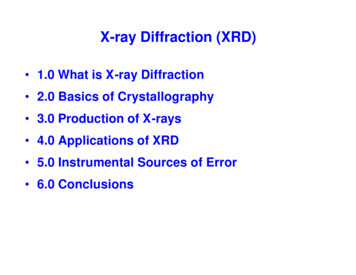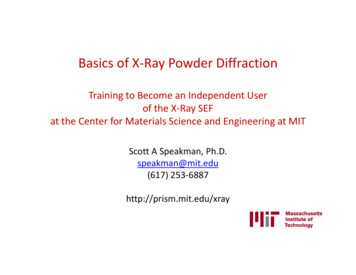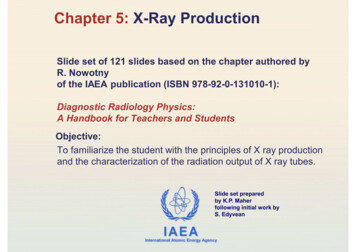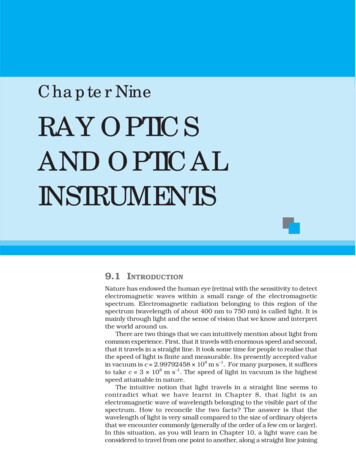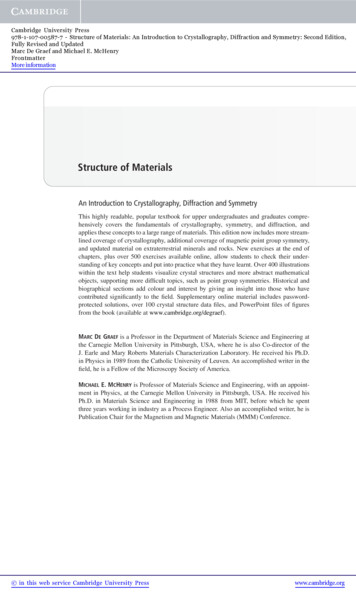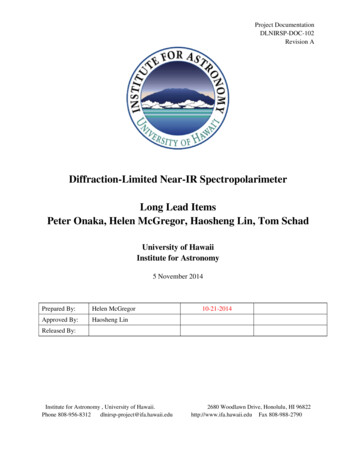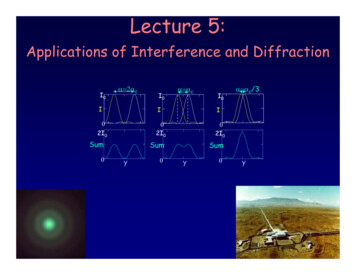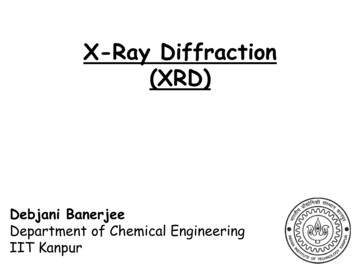
Transcription
X-Ray Diffraction(XRD)Debjani BanerjeeDepartment of Chemical EngineeringIIT Kanpur
X-ray Generation & typical spectrumConventional X-ray Source & Synchrotron:
Interaction of X-rays with matterIncident X-raysAbsorption (Heat)SPECIMENFluorescent X-raysElectronsScattered X-raysCoherentFrom bound chargesCompton recoilPhotoelectronsIncoherent (Compton modified)From loosely bound chargesTransmitted beamThe coherently scattered X-rays are the ones that are important fromXRD perspective.
Scale of Structure Organization
Diffraction Basics For electromagnetic radiation to be diffracted the spacing in the gratingshould be of the same order as the wavelength In crystals the typical interatomic spacing 2-3 Å so the suitable radiation isX-rays Hence, X-rays can be used for the study of crystal structures Neutrons and Electrons are also used for diffraction studies from materials. Neutron diffraction is especially useful for studying the magnetic orderingin materialsBeam of electronsTargetX-raysA accelerating charge radiates electromagnetic radiation
Mo Target impacted by electrons accelerated by a 35 kV potential shows the emissionspectrum as in the figure below (schematic)Intense peak, nearlymonochromaticIntensityK WhiteradiationK Characteristic radiation due to energy transitionsin the atom0.20.61.0X-ray sources with different fordoing XRD studiesTargetMetal Of K radiation (Å)Mo0.71Cu1.54Co1.79Fe1.94Cr2.291.4Wavelength ( )The high intensity nearly monochromatic K x-rays can be used as a radiation source forX-ray diffraction (XRD) studies a monochromator can be used to further decrease thespread of wavelengths in the X-ray
XRD the first step A beam of X-rays directed at a crystal interacts with the electrons of the atoms in the crystal. The electrons oscillate under the influence of the incoming X-Rays and become secondarysources of EM radiation. The secondary radiation is in all directions. The waves emitted by the electrons have the same frequency as the incoming X-rays coherent. The emission can undergo constructive or destructive interference.SecondaryemissionIncoming X-raysOscillating charge re-radiates In phase withthe incoming x-raysSchematicsSets nucleus into oscillationSets Electron cloud into oscillationSmall effect neglected
Crystalline materials are characterized by the orderlyperiodic arrangements of atoms.The (200) planesof atoms in NaClThe (220) planesof atoms in NaCl The unit cell is the basic repeating unit that defines a crystal. Parallel planes of atoms intersecting the unit cell are used todefine directions and distances in the crystal.– These crystallographic planes are identified by Millerindices.
The atoms in a crystal are a periodic array of coherentscatterers and thus can diffract light. Diffraction occurs when each object in a periodic array scattersradiation coherently, producing concerted constructive interference atspecific angles. The electrons in an atom coherently scatter light.– The electrons interact with the oscillating electric field of the lightwave. Atoms in a crystal form a periodic array of coherent scatterers.– The wavelength of X rays are similar to the distance betweenatoms.– Diffraction from different planes of atoms produces a diffractionpattern, which contains information about the atomicarrangement within the crystal X Rays are also reflected, scattered incoherently, absorbed, refracted,and transmitted when they interact with matter.
2012 was the 100th Anniversary of X-Ray Diffraction X-rays were discovered by WC Rontgen in 1895 In 1912, PP Ewald developed a formula to describe the passage of lightwaves through an ordered array of scattering atoms, based on thehypothesis that crystals were composed of a space-lattice-likeconstruction of particles. Maxwell von Laue realized that X-rays might be the correct wavelengthto diffract from the proposed space lattice. In June 1912, von Laue published the first diffraction pattern inProceedings of the Royal Bavarian Academy of Science.
The Laue diffraction pattern VonLaue’s diffraction pattern supportedtwo important hypotheses–X-rays were wavelike in nature andtherefore were electromagnetic radiation–The space lattice of crystals Bragg consequently used X-raydiffraction to solve the first crystalstructure, which was the structure ofNaCl published in June 1913. Single crystals produce “spot” patternssimilar to that shown to the right. However, powder diffraction patternslook quite different.The second diffraction patternpublished was of ZnS. Becausethis is a higher symmetrymaterial, the pattern was lesscomplicated and easier to analyze
An X-ray powder diffraction pattern is a plot of the intensityof X-rays scattered at different angles by a sample The detector moves in a circlearound the sample–The detector position is recorded asthe angle 2theta (2θ)–The detector records the number ofX-rays observed at each angle 2θ–The X-ray intensity is usuallyrecorded as “counts” or as “counts persecond” Many powder diffractometers usethe Bragg-Brentano parafocusinggeometry–To keep the X-ray beam properlyfocused, the incident angle omegachanges in conjunction with 2theta–This can be accomplished by rotatingthe sample or by rotating the X-raytube.
X-rays scatter from atoms in a material and therefore containinformation about the atomic arrangement The three X-ray scattering patterns above were produced by three chemicallyidentical forms SiO2 Crystalline materials like quartz and Cristobalite produce X-ray diffraction patterns–Quartz and Cristobalite have two different crystal structures–The Si and O atoms are arranged differently, but both have long-range atomic order–The difference in their crystal structure is reflected in their different diffractionpatterns The amorphous glass does not have long-range atomic order and therefore producesonly broad scattering features
Diffraction occurs when light is scattered by a periodic arraywith long-range order, producing constructive interferenceat specific angles The electrons in each atom coherently scatter light.–We can regard each atom as a coherent point scatterer–The strength with which an atom scatters light is proportional to the number ofelectrons around the atom. The atoms in a crystal are arranged in a periodic array with long-range order andthus can produce diffraction. The wavelength of X rays are similar to the distance between atoms in a crystal.Therefore, we use X-ray scattering to study atomic structure. The scattering of X-rays from atoms produces a diffraction pattern, whichcontains information about the atomic arrangement within the crystal Amorphous materials like glass do not have a periodic array with long-rangeorder, so they do not produce a diffraction pattern. Their X-ray scattering patternfeatures broad, poorly defined amorphous ‘humps’.
Crystalline materials are characterized by the long-range orderlyperiodic arrangements of atoms. Theunit cell is the basic repeating unit that defines the crystalstructure.–The unit cell contains the symmetry elements required to uniquely define thecrystal structure.–The unit cell might contain more than one molecule: for example, the quartz unit cell contains 3 complete molecules of SiO2.–The crystal system describes the shape of the unit cell–The lattice parameters describe the size of the unit cell Theunit cell repeats in all dimensions to fill space and produce themacroscopic grains or crystals of the material
The diffraction pattern is a product of the unique crystal structure of amaterial Thecrystal structure describes the atomic arrangement of a material. The crystal structure determines the position and intensity of thediffraction peaks in an X-ray scattering pattern.–Interatomic distances determine the positions of the diffraction peaks.–The atom types and positions determine the diffraction peak intensities. Diffractionpeak widths and shapes are mostly a function of instrumentand microstructural parameters.
Diffraction pattern calculations treat a crystal as a collectionof planes of atoms Each diffraction peak is attributed to the scattering from a specific setof parallel planes of atoms. Miller indices (hkl) are used to identify the different planes of atoms Observed diffraction peaks can be related to planes of atoms to assistin analyzing the atomic structure and microstructure of a sample
A Brief Introduction to Miller Indices The Miller indices (hkl) define the reciprocalaxial intercepts of a plane of atoms with theunit cell–The (hkl) plane of atoms intercepts the unit cell at a/ℎ,𝑏/𝑘, and 𝑐/𝑙–The (220) plane drawn to the right intercepts the unitcell at ½a, ½b, and does not intercept the c-axis. When a plane is parallel to an axis, it isassumed to intercept at ; therefore itsreciprocal is 0 The vector dhkl is drawn from the origin of theunit cell to intersect the crystallographic plane(hkl) at a 90 angle.–The direction of dhkl is the crystallographicdirection.–The crystallographic direction is expressed using []brackets, such as [220]
The diffraction peak position is a product of interplanarspacing, as calculated by Bragg’s law Bragg’s law relates the diffraction angle, 2θ, to dhkl– In most diffractometers, the X-ray wavelength λ is fixed.– Consequently, a family of planes produces a diffraction peak only at a specificangle 2θ. dhkl is a geometric function of the size and shape of the unit cell– dhkl is the vector drawn from the origin to the plane (hkl) at a 90 angle.– dhkl, the vector magnitude, is the distance between parallel planes of atoms inthe family (hkl)– Therefore, we often consider that the position of the diffraction peaks aredetermined by the distance between parallel planes of atoms.
The diffraction peak intensity is determined by thearrangement of atoms in the entire crystal The structure factor Fhkl sums the result of scattering from all of the atoms inthe unit cell to form a diffraction peak from the (hkl) planes of atoms. The amplitude of scattered light is determined by:– where the atoms are on the atomic planes this is expressed by the fractional coordinates xj yj zj– what atoms are on the atomic planes the scattering factor fj quantifies the efficiency of X-rayscattering at any angle by the group of electrons in each atom– The scattering factor is equal to the number of electronsaround the atom at 0 θ, the drops off as θ increases Nj is the fraction of every equivalent position that is occupiedby atom j
Bragg’s law provides a simplistic model to understand what conditionsare required for diffraction. For parallelplanes of atoms, with a space dhkl between the planes,constructive interference only occurs when Bragg’s law is satisfied.– In our diffractometers, the X-ray wavelength λ is fixed.– A family of planes produces a diffraction peak only at a specific angle 2θ. Additionally, the plane normal [hkl] must be parallel to thediffraction vector s– Plane normal [hkl]: the direction perpendicular to a plane of atoms– Diffraction vector s: the vector that bisects the angle between the incidentand diffracted beam
Many powder diffractometers use the Bragg-Brentanoparafocusing geometry.
A single crystal specimen in a Bragg-Brentano diffractometerwould produce only one family of peaks in the diffraction pattern.
A polycrystalline sample should contain thousands of crystallites.Therefore, all possible diffraction peaks should be observed. For every set of planes, there will be a small percentage of crystallites that areproperly oriented to diffract (the plane perpendicular bisects the incident anddiffracted beams). Basic assumptions of powder diffraction are that for every set of planes there is anequal number of crystallites that will diffract and that there is a statistically relevantnumber of crystallites, not just one or two.
Powder diffraction is more aptly named polycrystallinediffraction Samples canbe powder, sintered pellets, coatings on substrates,engine blocks. The ideal “powder” sample contains tens of thousands of randomlyoriented crystallites– Every diffraction peak is the product of X-rays scattering from an equal numberof crystallites– Only a small fraction of the crystallites in the specimen actually contribute tothe measured diffraction pattern XRPD is a somewhat inefficient measurement technique Irradiating a larger volume of material can help ensure that astatistically relevant number of grains contribute to the diffractionpattern–Small sample quantities pose a problem because the sample size limits thenumber of crystallites that can contribute to the measurement
X-rays are scattered in a sphere around the sample Each diffraction peak is actually a Debye diffraction cone produced by thetens of thousands of randomly oriented crystallites in an ideal sample.–A cone along the sphere corresponds to a single Bragg angle 2theta The linear diffraction pattern is formed as the detector scans along an arcthat intersects each Debye cone at a single point Only a small fraction of scattered X-rays are observed by the detector.
X-Ray Powder Diffraction (XRPD) is a somewhatinefficient measurement technique Only asmall fraction of crystallites in the sample actually contribute tothe observed diffraction pattern–Other crystallites are not oriented properly to produce diffractionfrom any planes of atoms–You can increase the number of crystallites that contribute to themeasured pattern by spinning the sample Only a small fraction of the scattered X-rays are observed by thedetector–A point detector scanning in an arc around the sample only observesone point on each Debye diffraction cone–You can increase the amount of scattered X-rays observed by using alarge area (2D) detector
Diffraction patterns are collected as absolute intensity vs 2θ,but are best reported as relative intensity vs dhkl. The peak position as 2theta depends on instrumental characteristicssuch as wavelength.–The peak position as dhkl is an intrinsic, instrument-independent,material property. Bragg’s Law is used to convert observed 2θ positions to dhkl. The absolute intensity, i.e. the number of X rays observed in a givenpeak, can vary due to instrumental and experimental parameters.–The relative intensities of the diffraction peaks should be instrumentindependent. To calculate relative intensity, divide the absolute intensity ofevery peak by the absolute intensity of the most intense peak,and then convert to a percentage. The most intense peak of aphase is therefore always called the “100% peak”.–Peak areas are much more reliable than peak heights as a measureof intensity.
Powder diffraction data consists of a record of photon intensityversus detector angle 2θ. Diffraction data can be reduced to a list of peak positions and intensities–Each dhkl corresponds to a family of atomic planes {hkl}–individual planes cannot be resolved- this is a limitation of powder diffraction versussingle crystal diffraction
You can use XRD to determine Phase Composition of a Sample– Quantitative Phase Analysis: determine the relative amounts of phases in amixture by referencing the relative peak intensities Unit cell lattice parameters and Bravais lattice symmetry– Index peak positions– Lattice parameters can vary as a function of, and therefore give you informationabout, alloying, doping, solid solutions, strains, etc. Residual Strain (macrostrain) Crystal Structure– By Rietveld refinement of the entire diffraction pattern Epitaxy/Texture/Orientation Crystallite Size and Microstrain– Indicated by peak broadening– Other defects (stacking faults, etc.) can be measured by analysis of peak shapesand peak width
Phase Identification The diffraction pattern for every phase is as unique as yourfingerprint– Phases with the same chemical composition can have drastically differentdiffraction patterns.– Use the position and relative intensity of a series of peaks to matchexperimental data to the reference patterns in the database
The diffraction pattern of a mixture is a simple sum of the scatteringfrom each component phase
Databases such as the Powder Diffraction File (PDF)contain dI lists for thousands of crystalline phases. The PDF contains over 200,000 diffraction patterns.Modern computer programs can help you determine what phases arepresent in your sample by quickly comparing your diffraction data to all ofthe patterns in the database.The PDF card for an entry contains a lot of useful information, includingliterature references.
You cannot guess the relative amounts of phases based onlyon the relative intensities of the diffraction peaks Thepattern shown above contains equal amounts of TiO2 and Al2O3 The TiO2 pattern is more intense because TiO2 diffracts X-rays moreefficientlyWith proper calibration, you can calculate the amount of each phasepresent in the sample
Unit Cell Lattice Parameter Refinement By accurately measuring peak positions over a long range of 2theta,you can determine the unit cell lattice parameters of the phases inyour sample– alloying, substitutional doping, temperature and pressure, etccan create changes in lattice parameters that you may want toquantify– use many peaks over a long range of 2theta so that you canidentify and correct for systematic errors such as specimendisplacement and zero shift– measure peak positions with a peak search algorithm or profilefitting profile fitting is more accurate but more time consuming– then numerically refine the lattice parameters
Crystallite Size and Microstrain Crystallites smaller than 120nm create broadening of diffractionpeaks– this peak broadening can be used to quantify the average crystallite size ofnanoparticles using the Scherrer equation– must know the contribution of peak width from the instrument by using acalibration curve microstrain may also create peak broadening– analyzing the peak widths over a long range of 2theta using a Williamson-Hullplot can let you separate microstrain and crystallite size00-043-1002 Cerianite- - CeO2Intensity (a.u.)K B 2q L cos q23 242526272829303132332q (deg.)343536 3738 394041
Preferred Orientation (texture) Preferred orientation of crystallites can create asystematic variation in diffraction peak intensities– can qualitatively analyze using a 1D diffraction pattern– a pole figure maps the intensity of a single peak as a functionof tilt and rotation of the sample this can be used to quantify the texture10.000-004-0784 Gold - 22)2.0(400)x10340506070Two-Theta (deg)8090100
Non-ideal samples: Texture (i.e. preferred crystallographicorientation) Thesamples consists of tens of thousands of grains, but the grains arenot randomly oriented–Some phenomenon during crystallization and growth, processing, orsample preparation have caused the grains to have preferredcrystallographic direction normal to the surface of the sample
Essential Parts of the Diffractometer X-rayTube: the source of X Rays Incident-beam optics: condition the X-ray beam before it hits thesample The goniometer: the platform that holds and moves the sample,optics, detector, and/or tube The sample & sample holder Receiving-side optics: condition the X-ray beam after it hasencountered the sample Detector: count the number of X Rays scattered by the sample
X-radiation for diffraction measurements is producedby a sealed tube or rotating anode. Sealed X-ray tubes tend to operate at 1.8to 3 kW. Rotating anode X-ray tubes produce muchmore flux because they operate at 9 to 18kW.–A rotating anode spins the anode at 6000rpm, helping to distribute heat over alarger area and therefore allowing the tubeto be run at higher power without meltingthe target. Both sources generate X rays by strikingthe anode target with an electron beamfrom a tungsten filament.–The target must be water cooled.–The target and filament must becontained in a vacuumBe is transparent to x-rays, so it's used in the windows of x-ray tubes, which need to bestrong enough to hold a perfect vacuum, yet thin enough to let the delicate x-rays out.
The wavelength of X rays is determined by the anode ofthe X-ray source Electrons from the filament strike the target anode, producing characteristic radiationvia the photoelectric effect. The anode material determines the wavelengths of characteristic radiation. While we would prefer a monochromatic source, the X-ray beam actually consists ofseveral characteristic wavelengths of X rays.
Spectral Contamination in Diffraction Patterns The Kα1 & Kα2 doublet will almost always be present–Very expensive optics can remove the Kα2 line–Kα1 & Kα2 overlap heavily at low angles and aremore separated at high angles W lines form as the tube ages: the W filamentcontaminates the target anode and becomes a new Xray source W and Kβ lines can be removed with optics
Monochromators remove unwanted wavelengths ofradiation from the incident or diffracted X-ray beam. Diffraction from a monochromator crystal can be used to select onewavelength of radiation and provide energy discrimination. Most powder diffractometer monochromators only remove K-beta, Wcontamination, and Brehmstralung radiation–Only HRXRD monochromators or specialized powder monochromators remove Kalpha2 radiation as well. A monochromator can be mounted between the tube and sample(incident-beam) or between the sample and detector (diffractedbeam)–An incident-beam monochromator only filters out unwanted wavelengths ofradiation from the X-ray source–A diffracted-beam monochromator will also remove fluoresced photons.–A monochromator may eliminate 99% of K-beta and similar unwanted wavelengthsof radiation.–A diffracted-beam monochromator will provide the best signal-to-noise ratio, butdata collection will take a longer time
Beta filters can also be used to reduce the intensity of K-beta and Wwavelength radiation A material with an absorptionedge between the K-alpha and Kbeta wavelengths can be used as abeta filter This is often the element justbelow the target material on theperiodic table–For example, when using Curadiation Cu K-alpha 1.541 Å Cu K-beta 1.387 Å The Ni absorption edge 1.488 Å–The Ni absorption of Curadiation is: 50% of Cu K-alpha 99% of Cu K-beta
Some atoms absorb incident X-rays and fluoresce them as X-rays of a differentwavelength–The absorption of X-rays decreases the diffracted signal–The fluoresced X-rays increase the background noise The increased background noise from fluoresced X-rays can be removed by using:–a diffracted-beam monochromator–an energy sensitive detector The diffracted beam signal can only be increased by using a different wavelength ofradiation The most problematic materials are those two and three below the target material:–For Cu, the elements that fluoresce the most are Fe and Co
The X-ray Shutter is the most important safety deviceon a diffractometer X-raysexit the tube through X-raytransparent Be windows. X-Ray safety shutters contain thebeam so that you may work in thediffractometer without being exposedto the X-rays. Being aware of the status of theshutters is the most important factor inworking safely with X rays.
Detectors point detectors–observe one point of space at a time slow, but compatible with most/all optics–scintillation and gas proportional detectors count all photons,within an energy window, that hit them–Si(Li) detectors can electronically analyze or filter wavelengths position sensitive detectors–linear PSDs observe all photons scattered along a line from 2 to10 long–2D area detectors observe all photons scattered along a conicsection
Preparing a powder specimen Anideal powder sample should have many crystallites in randomorientations–the distribution of orientations should be smooth and equally distributedamongst all orientations Large crystallite sizes and non-random crystallite orientations both leadto peak intensity variation–the measured diffraction pattern will not agree with that expected from an idealpowder–the measured diffraction pattern will not agree with reference patterns in thePowder Diffraction File (PDF) database If the crystallites in a sample are very large, there will not be a smoothdistribution of crystal orientations. You will not get a powder averagediffraction pattern.–crystallites should be 10mm in size to get good powder statistics
Grazing Incident Angle Diffraction (GIXD) Also called Glancing Angle X-Ray Diffaction The incident angle is fixed at a very small angle ( 5 ) so that X-rays arefocused in only the top-most surface of the sample. GIXD can perform many of analyses possible with XRPD with theadded ability to resolve information as a function of depth (depthprofiling) by collecting successive diffraction patterns with varyingincident angles–orientation of thin film with respect to substrate–lattice mismatch between film and substrate–epitaxy/texture–macro- and microstrains–reciprocal space map
Information in a Diffraction Pattern Phase IdentificationCrystal SizeCrystal QualityTexture (to some extent)Crystal Structure
Intensity (a.u.)Analysis of Single Phase2q( )d 3089.941.095I1: Intensity of the strongest peak
Procedure Note first three strongest peaks at d1, d2, and d3In the present case: d1: 2.82; d2: 1.99 and d3: 1.63 ÅSearch JCPDS manual to find the d group belonging to the strongestline: between 2.84-2.80 ÅThere are 17 substances with approximately similar d2 but only 4 haved1: 2.82 ÅOut of these, only NaCl has d3: 1.63 ÅIt is NaCl HurrahSpecimen and IntensitiesSubstanceFile Number2.829 1.999 2.26x 1.619 1.519 1.499 3.578 2.668(ErSe)2Q19-4432.82x 1.996 1.632 3.261 1.261 1.151 1.411 0.891NaCl5-6282.824 1.994 1.54x 1.204 1.194 2.443 5.622 4.892(NH4)2WO2Cl422-652.82x 1.998 1.263 1.632 1.152 0.941 0.891 1.411(BePd)2C18-225Caution: It could be much more tricky if the sample is oriented or textured or your goniometer is not calibrated
Presence of Multiple phases d (Å)I/I0.985741More ComplexPattern of Cu2ORemaining3.01 Lines 5Several permutations combinations possible2.47 I/I172dd (Å)I/I1e.g. d1; d2; and d3, the first three strongest lines show(Å)2.1328ObservedNormalized3.0209several alternatives2.09 *1003.01572.465100Then take any of the two lines togetherand match1.80 *522072 1.50100It turns out that 1st and 3rd strongest liesto Cu2.472.135belong37Patternfor Cu1.299and then all other peaks for Cu can be1.743separatedout I/I128391 d (Å) 2.1318Now separate the remaining lines and normalizethe1.50100 20 1.28 * 282.0881.510271.224intensities1.808469 1.08 *13201.287171.278 1.2920Look for first three lines and it turns outthat the36174 1.04 *1.2334 1.09 1.22phase is Cu2OIf more phases, more pain to solve 1.06740.97951.043650.9820.903834 0.829390.8083850.910.830.81**810
Lattice StraindoNo Strain2qUniform Strain q d strain2qNon-uniform StrainBroadeing b 2q 2 dtan qd2q
Texture in Materials Grains with in a polycrystalline are notcompletely randomly distributed Clustering of grains about some particularorientation(s) to a certain degree Examples:– Present in cold-rolled brass or steel sheets– Cold worked materials tend to exhibit sometexture after recrystallization Affects the properties due to anisotropicnature
Texture Fiber Texture– A particular direction [uvw] for all grains is more or less parallel to thewire or fiber axis e.g. [111] fiber texture in Al cold drawn wire– Double axis is also possible Example: [111] and [100] fiber textures in Cu wire Sheet Texture– Most of the grains are oriented with a certain crystallographic plane(hkl) roughly parallel to the sheet surface and certain direction [uvw]parallel to the rolling direction– Notation: (hkl)[uvw]
Texture in materials [uvw] i.e. perpendicular to thesurface of all grains is parallel toa direction [uvw]Also, if the direction [u1v1w1] isparallel for all regions, thestructure is like a single crystalHowever, the direction [u1v1w1]is not aligned for all regions, thestructure is like a mosaicstructure, also called as MosaicTexture
Pole Figures(100) pole figures for a sheet material(a) Random orientation (b) Preferred orientation
Thin Film SpecimenGrazing angle (very small, 1-5 )qBqBFilm or CoatingSubstrate Smaller volume i.e. less intensity of the scattered beamfrom the film Grazing angle– Useful only for polycrystalline specimens
Thin Film XRD Precise lattice constants measurements derived from 2q-q scans, whichprovide information about lattice mismatch between the film and thesubstrate and therefore is indicative of strain & stress Rocking curve measurements made by doing a q scan at a fixed 2 q angle,the width of which is inversely proportionally to the dislocation density inthe film and is therefore used as a gauge of the quality of the film. Superlattice measurements in multilayered heteroepitaxial structures,which manifest as satellite peaks surrounding the main diffraction peakfrom the film. Film thickness and quality can be deduced from the data. Glancing incidence x-ray reflectivity measurements, which can determinethe thickness, roughness, and density of the film. This technique does notrequire crystalline film and works even with amorphous materials.
Thin Films SpecimensqB1qB(hkl) plane of thesubstrateqB2BqB1 qB2Diffractionfrom fromhkl planei.e.No DiffractionhkloccursplaneSingle Crystal Substrate If the sample and substrate is polycrystalline, thenproblems are less But if even if one of them is oriented, problems arise In such situations substrate alignment is necessary
00280024 002600220020 0018 SrTiO3 (100)* 304050607080902216 20 10 SrTiO3 (110)405060708090 304016/041620 10014Log Intensity (a.u.) Bismuth Titanate thinfilms on oriented SrTiO3sub
Sets Electron cloud into oscillation Sets nucleus into oscillation Small effect neglected A beam of X-rays directed at a crystal interacts with the electrons of the atoms in the crystal. The electrons oscillate under the influence of the incoming X-Rays and become secondary sources of EM radiation. The secondary radiation is in all directions.
